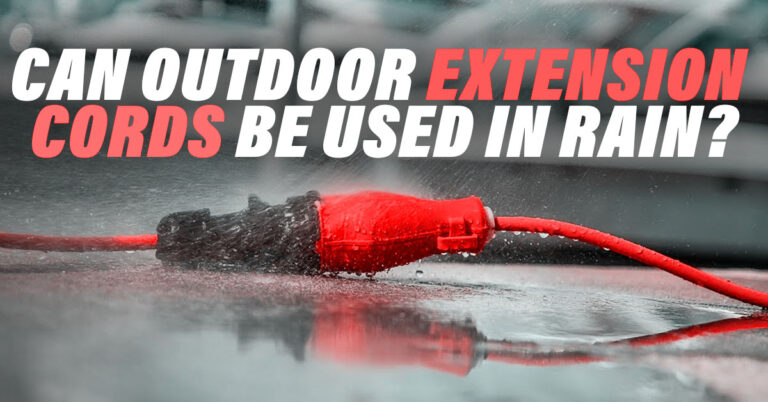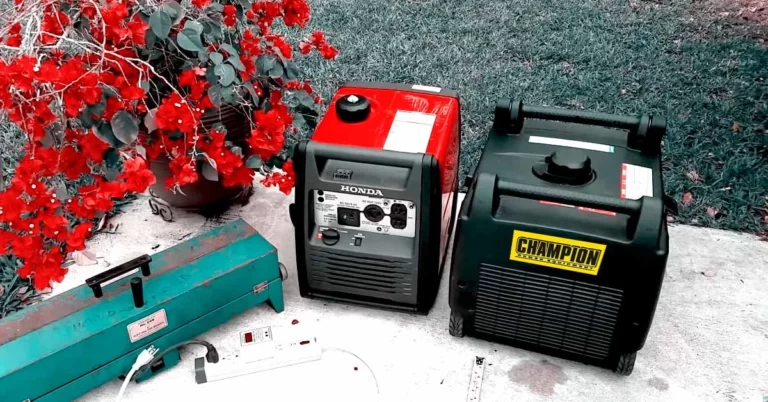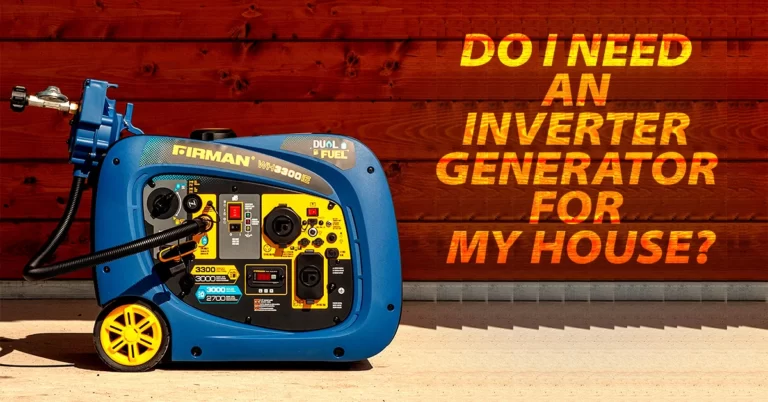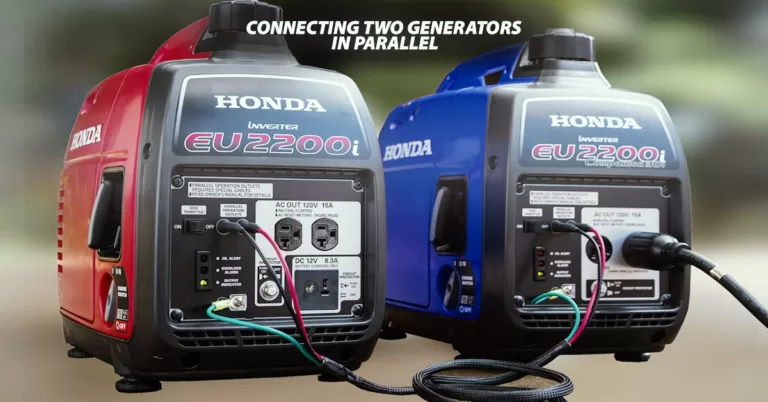How to Break in a Generator?
Breaking in a generator is essential for long-term reliability and peak performance, whether it’s portable, inverter, or standby. If you’re wondering how to break in a generator, follow key steps such as consulting the manual, gathering lubrication supplies, initiating the generator, oil change, and load run, all explained in detail below.
This post also provides valuable tips and insights on breaking in generators from various brands like Champion, WEN, and Pulsar, with the aim of maximizing their lifespan and efficiency of generator working.
How To Break In a Generator – Just Follow 9 Easy Steps
Breaking in a generator is a straightforward process that may take a few hours. Even if you’re new to handling generators, you can follow these essential steps for a successful break-in. While there are various recommendations online, it’s crucial to start with the manufacturer’s instructions.
These steps are necessary for all sizes of portable, inverter, and backup generators, whether they are small or larger in capacity. Just follow this step-by-step guide to ensure your generator’s longevity.
Consult Generator’s Manual
First, it involves thoroughly reviewing the operator’s manual for your generator. The manual offers valuable guidance for important tasks, like oil changes and proper usage. While it may not help you specifically outline breaking-in procedures, it typically gives recommendations for you, such as changing the oil within the initial few hours of operation, checking the frequency of oil changes, and addressing other important key points regarding generator breaking.
Get Supplies to Lubricate Generator
To prepare your generator for break-in, you’ll need to shop for specific supplies:
Fuel
Purchase the highest-octane gasoline available, as it’s recommended for your generator.
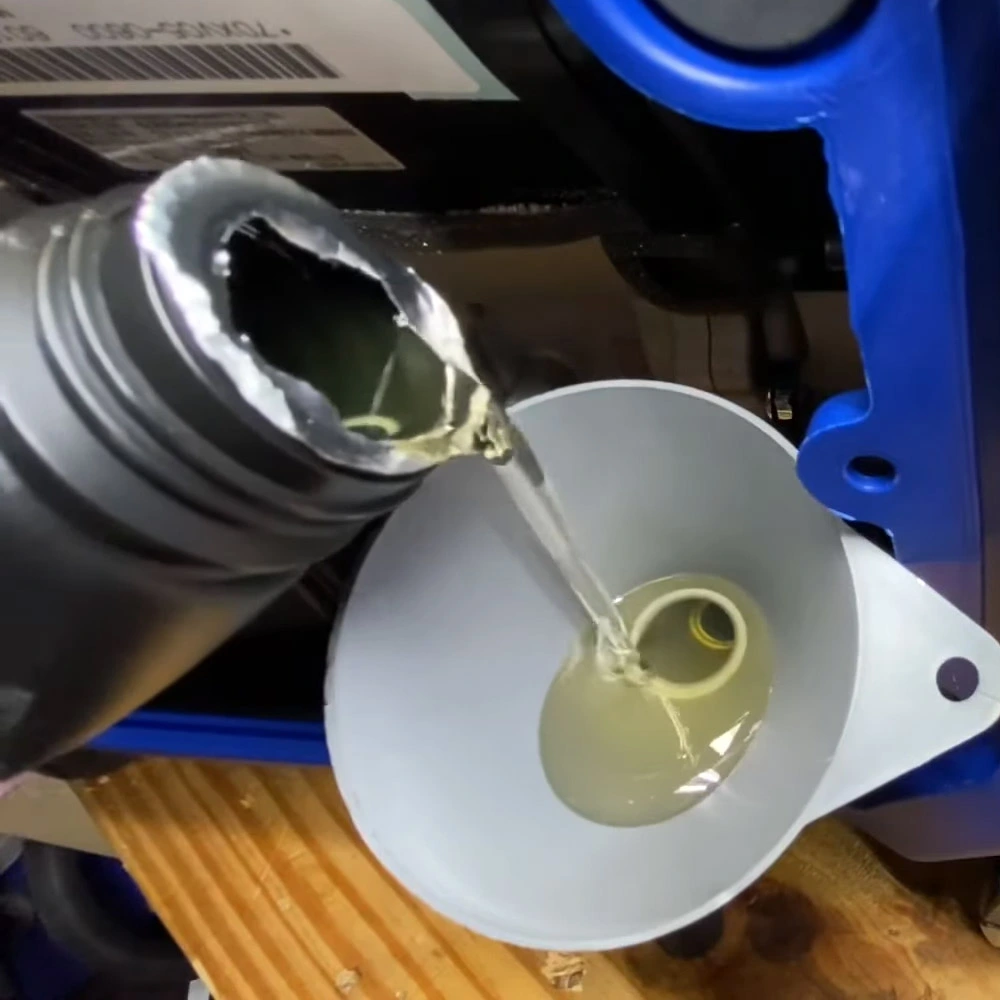
Oil
The generator’s maker recommends that you buy their brand of oil. Typically, a 10W-30 weight oil is suggested for average climate temperatures.
Funnel
Get a funnel to make pouring oil into your generator’s reservoir clean and mess-free. Avoid using the same funnel for both fuel and oil to prevent contamination.
Oil Conditioner
Consider getting an oil conditioner like Lukas Heavy Duty Oil Stabilizer or Marvel Mystery Oil. These products help prevent dry starts, a common cause of engine wear, by ensuring the oil adheres to cylinder walls. An Oil Conditioner is particularly useful if your generator has been idle for an extended period, as it safeguards internal parts from premature wear.
By following the operator’s manual and using these supplies, you’ll be well-prepared to lubricate and break in your generator properly.
Lubricate Spark Plug and Cylinder
To start the lubrication process for your generator, follow these steps:
- Carefully remove the spark plug using the appropriate wrench from your set.
- Add a few drops of oil conditioner (e.g., Lucas 10001) into the spark plug chamber.
- Do not attempt to start the generator before lubrication. After adding the conditioner, pull the starter cord slowly about 10 times, which helps the piston move up and down in the lubricated cylinder. This step is for lubrication only, not for starting the generator.
- If the spark plug chamber is hard to reach, you can use a funnel. Allow a few minutes for the oil conditioner to drip down from the funnel.
- Replace the spark plug securely. Ensure it is tightened properly.
- The cylinder wall is sufficiently lubricated if the pull cord feels smooth.
By following these steps, you ensure that the generator’s cylinder is properly lubricated before attempting to start it, which is crucial for its longevity and smooth operation.
Fill Reservoirs with Oil and Fuel
In this generator setup process:
Add Oil
With a funnel, pour the recommended amount of oil into the generator’s crankcase as specified in your generator operator’s manual. Wait for the oil to flow into all the intended areas, then check the oil level using the dipstick (if applicable) and top off as needed.
Fuel
Fill the generator’s fuel tank with the recommended fuel type. Consult your generator’s manual for guidance, and be sure to follow the octane recommendations. It’s a good practice to use high-grade gasoline when available, but be aware that some gasoline contains ethanol, which may necessitate a fuel additive to protect the engine.
Fuel Stabilizer
As per your generator manufacturer’s recommendation, add the correct amount of STA-BIL fuel stabilizer to the fuel tank.
Following these steps will help ensure that your generator is properly lubricated and fueled, ready for safe and efficient operation.
Start The Generator
To start the generator, follow these general guidelines:
- It’s important to refer to the manufacturer’s instructions for starting the generator because the steps may differ between recoil starters and electric start buttons.
- Try to start the generator once you’ve added fuel. Keep in mind that it may not start immediately with the first or second pull, so please exercise patience. Continue trying until the engine starts.
- Most generators feature an engine “on” or “off” switch, which, depending on the type, may also contain a “choke” option or a separate switch.
- When using the pull starter, be patient since it can take a few tries to get it going. Each pull helps the engine’s lubricating process.
- When the generator starts, you may need to adjust the choke option as per the instructions in the operator’s manual.
- During startup, don’t be alarmed if you see white smoke, as it is normal and results from the burning off of the oil conditioner added to the spark plug chamber.
Start your generator securely and efficiently by following these procedures.
Run the Generator ( 1 Hour )
To run your generator effectively, first, consult the manufacturer’s guidelines for the recommended initial runtime; if unspecified, run it for one hour at the lowest speed without any load. During this break-in period, you can connect a load as long as it doesn’t exceed 75% of the generator’s capacity.
Change the Engine Oil After 1 hour
After running the generator for 60 minutes without any load, you must follow the proper procedure for an oil change. This helps remove metal flakes and fragments, which can prevent engine wear. Avoid draining the oil immediately after turning off the hot engine; let it cool down first. Drain the motor oil into a container for disposal to eliminate most of the metal shavings created by the engine. Additionally, remove the magnetic dipstick and wipe off any remaining metal flakes with a clean cloth or kitchen towel before adding fresh oil and oil conditioner.
Optional Second Generator Start
To achieve a comprehensive cleaning procedure, you can choose to initiate a second engine startup. During this second operation, which also lasts for an hour and operates without any load, it effectively guarantees the collection of any residual metal fragments in the oil. After this, drain the oil again and refill it before your next use. The engine oil should be noticeably cleaner after the second run, effectively removing any remaining metal particles from the engine.
Do a Load Run
To conclude the break-in process for your generator, perform one more engine oil change, and don’t forget to include an oil conditioner after the second hour of operation. After this, it’s time for a load run. To ensure your generator is adequately broken in for full power use, connect devices drawing between 500 and 1000 watts of power and run it for one to two hours. While there are varying opinions that avoid running the generator at peak load.
Instead, some suggest running it at 75% of its wattage output, while others recommend running it until the fuel runs out. To complete the break-in process, operate your generator with a load, ideally equivalent to 1/3 of its rated wattage, for an additional hour, reaching a total of 3 hours of runtime for the break-in.
Considerations and Tips: How To Break In A Generator
| Important Considerations | Tips for Breaking in a Generator |
|---|---|
| Important Considerations | Ensure you follow these guidelines for generator maintenance. |
| Tips for Breaking in a Generator | Properly break in your generator for optimal performance. |
| Regular Maintenance | Consistently maintain your portable generator to prolong its lifespan. |
| First Oil Change | Change the oil within the first 20 hours of use or the first month, whichever comes first. |
| Air Filters | Check air filters before each use and clean them after 50 hours or 3 months of use. |
| Spark Plugs | Adjust spark plugs every 6 months and replace them annually. |
| Ethanol Fuel | Add a product like Sea Foam Motor Treatment if your area has ethanol-blended gasoline to prevent damage. |
| Follow Manufacturer’s Recommendations | Adhere to the manufacturer’s maintenance schedule in the manual. |
| Fuel Additive | Consider adding 1-2 ounces of fuel additive per gallon for cleaner and more stable fuel. |
| Oil Conditioner | When changing the oil, it’s advisable to add oil conditioner for improved performance. |
Do you know why it’s important to break in a new generator?
For numerous reasons, a new generator has to be broken in. It ensures that all parts requiring oil are properly lubricated, preventing potential damage and extending the generator’s lifespan. During this process, the generator is run to allow oil circulation and to remove any tiny metal fragments that could cause engine wear. Failure to follow the break-in procedure can lead to significant damage and a reduction in the lifespan of your generator, whether it’s small or large.
Does a new generator require a break-in period?
A break-in period is crucial for new generators, including portable, inverter, and standby generators. Ensuring proper oil lubrication protects the machine from potential damage. This short-period process is crucial and should not be skipped.
Should I Use Load or No Load for Generator Break-in?
There’s debate about breaking in a new generator with load or no load. Manufacturers provide varying recommendations; some suggest running the generator with no load for the first hour of the break-in period, while others advise a light load, typically around 25% of its capacity.
Operating the generator with no load aids in warming up and wearing in its components, while a light load accelerates piston ring seating and the overall break-in of components. Following the manufacturer’s advice is best. If not specified, starting with no load for an hour and then adding a load under 50% capacity is typically safe and effective.
Various Generator Break-In Methods
How To Break In Champion Generator?
To break in a new Champion generator:
- Follow a 5-hour break-in period.
- Begin with one hour of no load, then run it with a varied load below 50% of its capacity for the remaining 4 hours.
- Change the oil after these 5 hours.
How to Break In Firman Generator?
To break in a new Firman generator properly, the manufacturer recommends you change the oil after the first 25 hours of use and subsequently every 100 hours. They suggest using 10W 30 regular oil or 5W 30 synthetic oil in cold weather. You can choose a shorter break-in period if preferred. Additional tips include:
- Using high-quality fuel and oil.
- Closely monitoring the generator for issues.
- Following the owner’s manual’s maintenance schedule is the best way for long-lasting performance and reliability.
How to Break the WEN Generator?
To properly break in a new WEN generator, follow these steps:
- Run it for the first hour with no load.
- Next, you should proceed with a varied load, ensuring it remains below 50% of the generator’s rated capacity for 5-8 hours.
- Change the oil after this initial 5-8 hour period.
- Use high-quality fuel and oil, and closely monitor the generator for any issues.
- After the first hour, change the oil and add oil conditioner for the second and third hours of operation. These hours can be run with no load or at 1/2 load or less.
How to Break Pulsar Generator?
To properly break in your Pulsar generator, consult your owner’s manual for model-specific instructions, as break-in procedures can differ. One manual suggests a 20-hour break-in without overloading, followed by an oil change. If your manual lacks details, consider a 3 to 5-hour break-in or contact a Pulsar dealer. Generally, start with a no-load run for an hour, then vary the load below 50% of its capacity for 5 hours before an oil change. Use quality fuel and oil, and monitor the generator for any issues to ensure long-lasting performance.
Generator Break in Eco Mode
When breaking in a generator in Eco mode, refer to your manual since instructions can vary by model and technology. Old methods may not work for new machines, so use the right oil amount and prime the spark plug chamber. Avoid Eco mode during break-in to ensure proper component wear-in. To save fuel and quiet the vehicle after a break-in, choose Eco mode. To get exact instructions that apply to your model, always reference your handbook.
FAQs
How Long Does a Generator Need To Break in?
The best way to Properly break in a generator may take six to eight hours. These steps ensure that your generator receives proper engine lubrication and clears any residual debris before regular use.
Does a New Generator Require A Break-in Period?
Indeed, every new brand of portable inverter and backup generator should go through a break-in process. which includes reading the manual, adding fuel and oil, running the engine with oil changes to seat pistons and clear debris, and running it with a load.
Should You Give The Generator a Rest?
Yes, it’s essential to stop a gasoline generator from refueling, and you should allow five to ten minutes for the engine to cool before adding gasoline. Regular visual checks of the generator are also recommended.
Is I Necessary To Run a Generator More Than Once?
If you have followed the proper break-in steps, there should be no need to repeat the process.
Do I Need To Break In My New Generator Before Starting It?
You can start the generator after filling the oil and gas, but failing to lubricate the engine’s moving parts properly can shorten its lifespan and cause damage to some engine components.
Should I Run My Generator At Full Capacity During The Break-in Period?
No, using the generator at full capacity during the break-in time is not advised. Instead, it’s advised to operate it at a moderate capacity to allow the engine to gradually increase in temperature and pressure without being overly stressed.
Can I Use Any Fuel During The Break-in Period?
Suppose you want optimal engine performance during the break-in period. In that case, it’s advisable to use premium fuel, ensuring that you achieve the best results for your generator. A fuel stabilizer can also be used to assist in stopping the gasoline from degrading and perhaps hurting the engine.
Is Breaking in a New Generator Necessary?
To improve the lifetime and performance of a new generator, breaking it in is required. It lubricates moving parts, prevents hard starts, and removes damaging metal shavings from the engine.
Is There a Honda Generator Break-in Period?
Certainly, it is advisable to break in a new Honda generator for the initial 5 hours of operation before subjecting it to full load, that practice contributes to a generator’s longevity and trouble-free performance.
What is The Break-in Process For a Predator 2000 Generator?
If the Predator 2000 manual is not available, you can follow these recommended break-in practices:
_ Run for the first hour without adding any load.
_ Apply a load below 50% of the generator’s rated capacity, varying the load periodically for a total of 5 hours.
_ After the first 5 hours of use, change the oil.
_ Use high-quality fuel and oil, and carefully monitor the generator for any signs of issues.
End Words
Breaking in a generator is an essential process to ensure its long-term reliability and peak performance, regardless of whether it’s a portable, inverter, or standby model. By consulting the generator’s manual, gathering the necessary lubrication supplies, and following the step-by-step guide outlined in this article on how to break in a generator, you can properly break in your generator and maximize its lifespan and efficiency.


